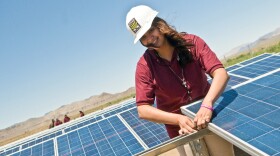In the battle for hearts and minds over Nevada’s now defunct net-metering program, two new reports conclude the program actually benefits all utility users. But that won’t be enough to settle the issue.
Ever since the state’s Public Utilities Commission put an end to lower rates for rooftop solar users at the beginning of this year, solar advocates and NV Energy have been waging messaging wars.
“A lot of the argument in the last few months has been centered around: are we subsidizing these 23,000 rooftop-solar customers in Nevada, if they have a lower power bill?'" says Riley Snyder, a reporter for KTNV and Politifact in Vegas.
The PUC determined that yes, net-metering does create an unfair cost shift to other ratepayers, but two new studies say no.
One of them was conducted by the non-partisan Brookings Institution, while the other comes from SolarCity, which shuttered its extensive Nevada operations.
Snyder recently examined the subsidy claim in a fact-checking piece for Politifact.
“My fact check…was that the Public Utilities Commission…they basically came up with 11 different factors that impact whether or not there is a cost shift for rooftop solar. They based it on what South Carolina did. And the issue with them was that of these 11, they were only really able to put hard numbers on two of them, and that leaves nine more.”
He says the two latest studies are trying to take a broader look at all the costs and benefits. Indeed, those studies found a net benefit of $7 million to $14 million per year*, with the higher figure factoring in things such as environmental and health-related benefits.
“Basically it really just depends on what the criteria you’re using to measure the cost and benefits. It’s why the PUC can come up with this $100 million cost shift, and then these other groups can come up with ‘Well, actually, there’s a subsidy’ using the same figures.”
Snyder concludes that the cost shifting claimed by NV Energy and its supporters needs more evidence.
“If there is a cost shift, if you go with what this group Solar Energy Fairness was saying [see link], the impact on your monthly energy bill ends up being like $3 dollars a month, which isn’t too awful, but over an extended period of time, if more people get on rooftop solar, there’s always the potential for it to change.”
If all of this seems confusing, there is some good news. The governor’s New Energy Industry Task Force recently recommended a legislative fix to grandfather in existing solar customers under old rates. And, Snyder says, the PUC is also ordering yet another study be done to get a better, more neutral sense on who’s really benefiting.
*This post has been modified to clarify that only the $14 million figure included in the study reflected those additional factors.






